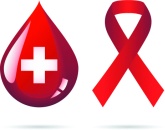 One of the most common activities associated in a medical emergency is blood transfusion, which allows a profusely bleeding patient to immediately receive blood that is vital for life. Excessive bleeding may damage the body and thus treatment such as blood transfusion during an emergency may prevent further deterioration of the patient’s general condition. Hospitals routinely invite the public to donate blood, which is generally stored in their blood bank and used during emergency situations. The stored blood may also be used during treatment of cancer patients who are in need of blood replacement for blood cells that have incurred damage from chemotherapy.
One of the most common activities associated in a medical emergency is blood transfusion, which allows a profusely bleeding patient to immediately receive blood that is vital for life. Excessive bleeding may damage the body and thus treatment such as blood transfusion during an emergency may prevent further deterioration of the patient’s general condition. Hospitals routinely invite the public to donate blood, which is generally stored in their blood bank and used during emergency situations. The stored blood may also be used during treatment of cancer patients who are in need of blood replacement for blood cells that have incurred damage from chemotherapy.
Blood transfusion is considered as an essential procedure for emergency medical treatment, allowing a patient to receive oxygen that is delivered by the blood cells. Erythrocytes, or the blood cells present in blood, are capable of storing and transporting oxygen molecules to the rest of the body, thus maintaining normal physiologic levels that are essential for life. During an emergency that involves severe physical damage and bleeding, blood transfusion has been used as an immediate treatment to replenish the amount of blood lost by an injured patient.
Advertisement
The Emergency Behind Blood Transfusion
Based on the importance of blood transfusion in emergency medical treatment, blood donation is thus considered by society as a way of helping others. Certain members of society opt to donate blood on a regular basis, with the hope that somehow, they have helped someone that may remain anonymous to them for the rest of their lives. Blood donation may be a gallant way of serving others, by allowing hospitals to use this fluid for emergency and medical treatment.
Unfortunately, the interest in blood donation has been tinged with controversy and social damage, due to the participation of gay donors. Certain concerned members of society have expressed their concern that gay individuals should be prevented from donating blood for emergency and medical treatment. This stand mainly originated from the fear of spreading viral diseases such as the acquired immunodeficiency syndrome (AIDS), and other sexually transmitted diseases (STDs), such as gonorrhea and syphilis. This blood donation controversy may inflict damage on the morale and privacy of the gay population and thus this needs to be reviewed in the most objective and scientifically robust manner.
RELATED READING: Diagnosing Breast Cancer and Your Weight
According to a recent report published in the journal Sexually Transmitted Diseases, the fear for the spread of viral diseases through contaminated blood may be imminent, yet hospitals and health agencies have also taken a proactive role in screening these blood samples before being used for emergency and medical treatment. By reviewing approximately 1,809 studies from around the world, the proponents of the research showed that several measures have been established in determining which blood samples are not fit for emergency transfusion and treatment due to the possible health damage to recipient patient. Hospitals have also adapted electronic approaches in their medical records that would alert hospital personnel of any contaminated blood samples. Routine screening of donated blood are also being conducted in hospitals, making use of specific antibodies that can detect the presence of viruses in the blood. If a specific blood donor is determined to carry a particular virus, then the appropriate treatment is also administered to control further damage to the donor’s health and prevent the spread of the virus across society.
The concern of society for the presence of viruses in donated blood may be real, yet it is also important to realize that hospitals have also developed strategies to address its potential damage to health. It is quite saddening that the association of viral diseases and gay individuals is strong, yet this should also be prevented from further inflicting damage to this specific subpopulation. The findings of the recent medical report may thus help readers understand that government agencies are also aware of the problem of transmitting viral diseases through blood donation, yet the potential damage to public health may also be addressed by adopting the corresponding screening activities to prevent further contamination.
